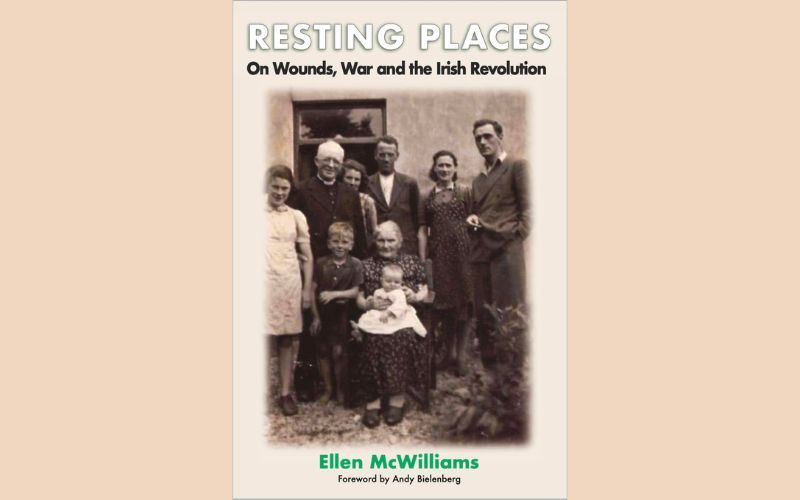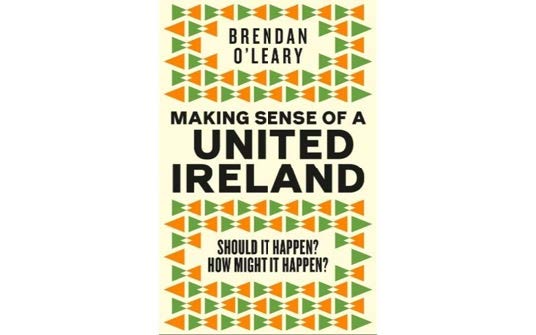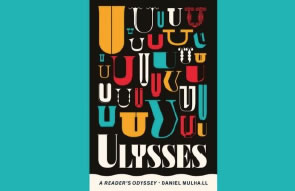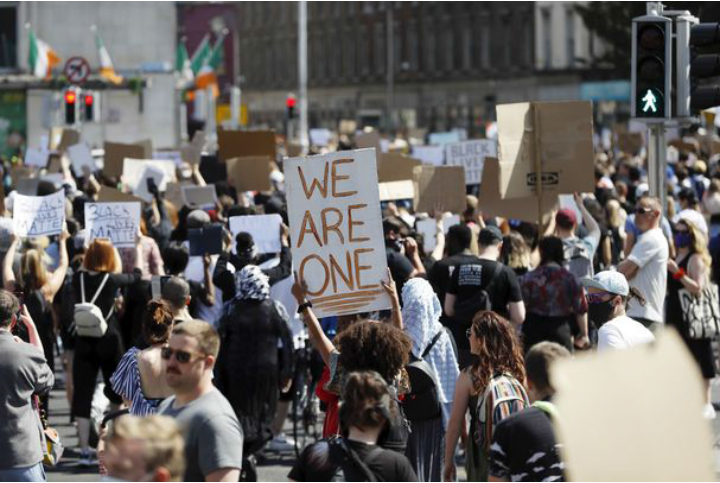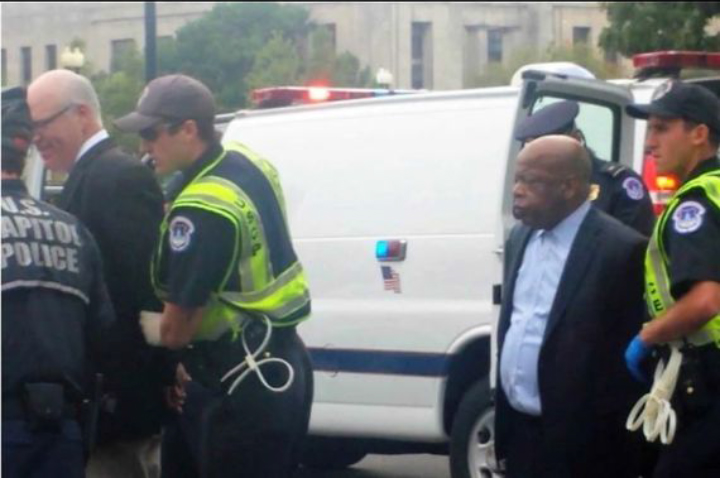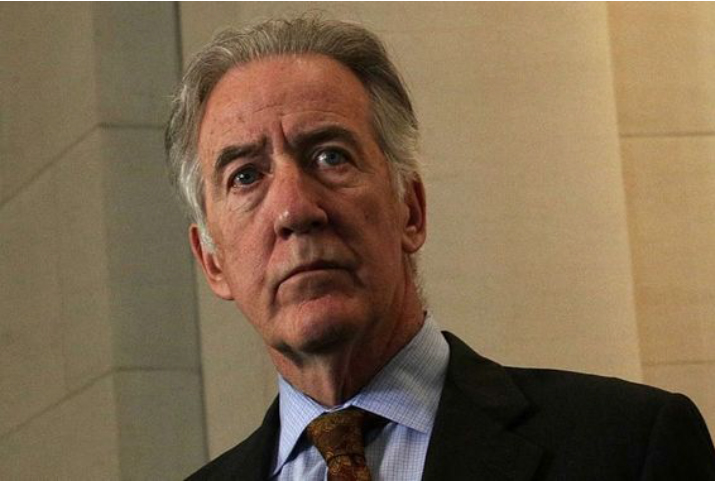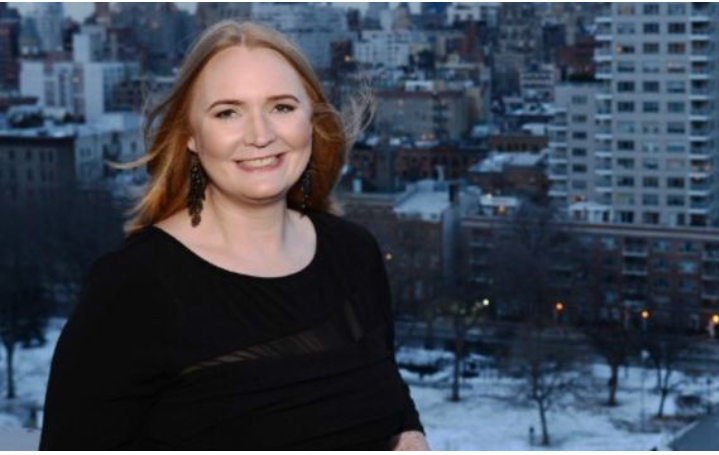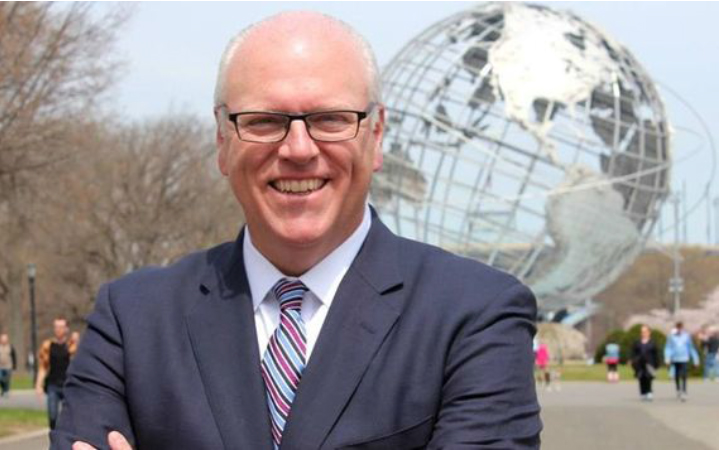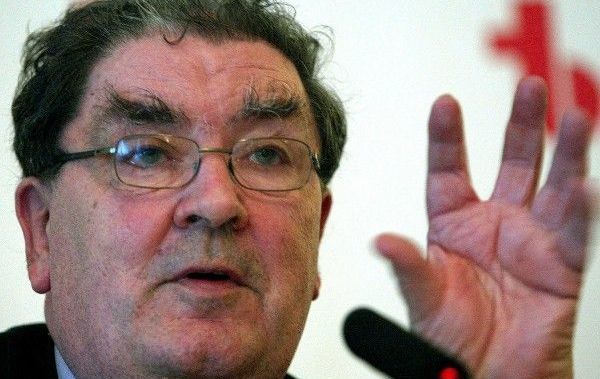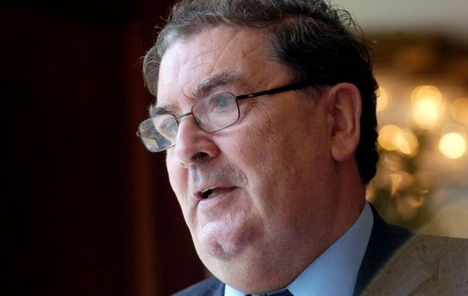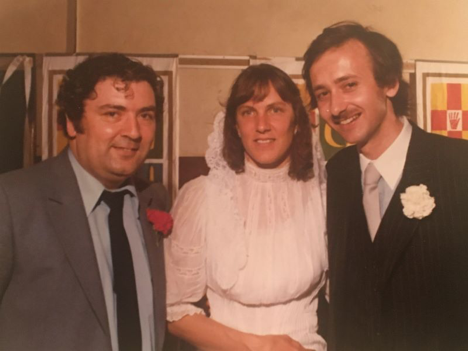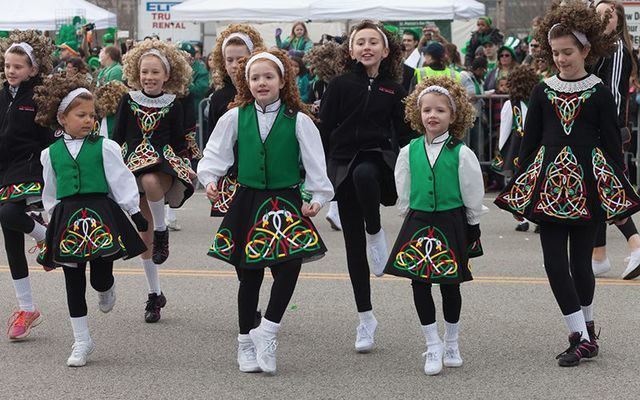IRISH CENTRAL
May 14, 2024
"Resting Places" - new insights into the traumatic history of Ireland 100 years ago
Ted Smyth reviews Irish author Ellen McWilliams' latest book
"Resting Places: On Wounds, War, and the Irish Revolution."
November10, 2023
Book Review: Martin Doyle's Dirty Linen
By Ted Smyth
September 9, 2022
What’s next for the North as the tectonic plates shift?
One of the great experts points the way
A review of the new book "Making Sense of a United Ireland"
January 18, 2022
Understanding Ireland through James Joyce’s “Ulysses”
A review of the new book "Ulysses: A Reader's Odyssey,"
December 15, 2021
Ted Smyth to be honored by
Irish Business Organization of New York
October 23, 2020
How Joe Biden and his daughter helped save the dolphins
September 18, 2020
Can you be both New York and Irish? Leading Irish writers reflect on heritage
A collection of essays that reflects on being Irish in America.
July 30, 2020
Sixty Irish American leaders call for end to racism in honor of John Lewis
August 5,2020
"Great peacemaker" John Hume remembered by longtime friend Ted Smyth
Feb 25, 2020
Family friendly ways to celebrate St. Patrick's Day in NYC
What are the best ways to spend St Patrick's Day in New York?
April 26, 2019
The future for Irish America is more Irish Studies programs across the US
December 13, 2019
Irish America has a vital role in North’s future and in US-Europe Relations,
"Resting Places" - new insights into the traumatic
history of Ireland 100 years ago
Ted Smyth reviews Irish author Ellen McWilliams' latest book
"Resting Places: On Wounds, War, and the Irish Revolution."
Ted Smyth, President Board of Advisors, Glucksman Ireland House, New York University
The “Decade of Centenaries” in Ireland, which ended recently is a good time to read an excellent and moving book by Ellen McWilliams, "Resting Places: On Wounds, War, and the Irish Revolution." The book which is part transnational history, part family memoir, explores the violent events of 100 years ago in her native West Cork where she grew up in the 1980s. "Resting Places" is even more relevant given the Irish Civil War Fatalities Project developed last month by Dr. Andy Bielenberg and University College Cork to investigate the number of people killed during the Civil War.
McWilliams, in dedicating her book to the Protestant families “who lost so much to the Dunmanway Massacre in 1922 and to her mother’s family “who sacrificed so much for Irish independence,” seeks to understand why there was so much brutality and the effect it had on succeeding generations.
With a Faulknerian appreciation that “the past is never dead, it’s not even past,” the author believes we should acknowledge how this violent past haunts the present, in her case her extended family and neighbors caught up in the violence and brutality of the War of Independence and the Civil War.
The renowned Irish war correspondent and broadcaster, Fergal Keane, describes "Resting Places" as “a work of eloquent, haunting beauty, a song of mourning and revelation that deserves the widest possible audience.” Keane continues, “This is a story rooted in a place and time, but it is truly the history of all wars in all times.”
McWilliams exposes the horrific events of 100 years ago, including when the Black and Tans murdered and tortured Irish people in Cork, a county divided between the political extremes of pro-British Orangeism (Bandon was an Orange Order bastion in the early 20th century) and the fierce Republican zeal of Dan Barry and the West Cork IRA Brigade, in which the author’s grandfather’s family were active.
The author, a Catholic from a staunch Irish Republican family, is particularly haunted by the murder in April, 1922 of 14 Protestants in Dunmanway, the town where she grew up. These killings, which were denounced at the time by the Sinn Féin Provisional Government in Dublin and the anti-Treaty side which controlled west Cork, probably related to revenge for the killing of an IRA officer, Michael O’Neill, during an armed raid of a Protestant house. However, sectarian hostility was also a factor and led some Protestants to flee to other parts of Ireland or to England.
McWilliams, who teaches Transatlantic Literary Relations, American Literature, and Irish Literature at the University of Exeter in England, is well qualified to understand the conflicting loyalties that beset Irish and British history. Married to an English historian who specializes in the English Civil War, she often wrestles with both academic correctness and British inability to understand Ireland’s separate nationhood.
McWilliams also riffs on her own life and its big and small challenges ranging from combining motherhood with a full-time career, academic chauvinism, and the failure in England to understand Irish history.
Some of the readers of IrishCentral would have known her grand-uncle, Gerry Foley, who like many on the losing side of the Civil War, emigrated to New York City to be employed in the back-breaking work of digging tunnels for the subway system. McWilliams wonders how these men recovered from two Irish wars and survived in exile, although many found friendship and love amidst the very large Irish community in the city.
Gerry Foley became prominent in the IRA Veterans Group in New York and the book features photographs of him in the 1970s marching with the Sean Oglaigh na hEireann contingent in the St Patrick’s Day parade, and another at a meeting with Frank Durkan, the human rights lawyer.
McWilliams herself spent a year teaching at Fordham University researching the writer, Maeve Brennan, daughter of the Irish revolutionary Robert Brennan (later Irish Ambassador to the United States). Brennan was a celebrated writer at the New Yorker who wrote sketches about New York life in the Talk of the Town section under the pseudonym “The Long-Winded Lady.” McWilliams notes that some of Brennan’s stories “seek justice for the abused Irish working classes in America,” a theme that recurs in the author’s own wanderings in the old Irish neighborhoods of the Bronx and Queens.
The author has written that "Resting Places" is a book about the madness of history and the fear of it, the need to outrun it. “I confess this with some trepidation, even though this book is in all ways honest – honest about the anguish and outrage that drove the writing on – because such honesty carries the risk of being considered strange, eccentric, beyond the pale even,” she states.
In many ways, "Resting Places" echoes the words of the historian Kim Wagner quoted by Martin Doyle in his magisterial book "Dirty Linen," “We are not responsible for the past, but we are responsible for what we choose to remember and what we choose to forget.” This is as true of the events of 100 years ago as it is of those over 30 years ago in what Seamus Heaney called the “man-killing parishes.”
Above all, "Resting Places" is a brave and highly engaging book that provides new insights into the traumatic history of Ireland 100 years ago, while suggesting ways in which we can remember and reconcile those bitter divisions today.
Martin Doyle's "Dirty Linen" is a personal, searing history of the Northern Ireland conflict seen through the microcosm of the rural parish of Tullyishin Co Down.
By Ted Smyth, President, Glucksman Ireland House, New York University
IrishCentral Nov 10, 2023"
"Dirty Linen: The Troubles in My Home Place" by Martin Doyle. IRISH ACADEMIC PRESS
Dirty Linen is a powerful and intimate book, beautifully written by Irish Times Books Editor Martin Doyle.
It is a personal, searing history of the Northern Ireland conflict seen through the microcosm of a single rural parish where Doyle grew up. The parish is Tullylish on the banks of the Bann, near Banbridge, Co Down, halfway between Belfast and the border.
Tullylish was on the edge of the Murder Triangle, the scene of some of the most horrific killings of innocent men, women, and children in the North by the IRA and UVF. Ordinary Catholics and and Protestants were the easy targets for revenge killings by paramilitaries who randomly shot and maimed the people in the middle, hardworking family people, who believed in peaceful persuasion to support reconciliation.
“These victims were the mortar that held the North together, the best of us,” notes Doyle, “the ones who crossed the aisle without even giving it a thought.”
The “Troubles” began in Tullylish after the civil rights movement was started by Austin Currie, John Hume, and Bernadette Devlin to end discrimination against Northern Irish Catholics. British loyalists soon violently attacked these peaceful marchers determined to protect Protestant Unionist supremacy in the North. Catholics were burned out of their homes in Belfast, with the police standing by.
The Catholic, nationalist community then resorted to armed self-defense but, Doyle says, that quickly deteriorated into tit-for-tat car bombs and murders that terrorized ordinary people again, and again.
Doyle is critical of the British Government’s failure to investigate security force collusion in some of the killings of nationalists during the conflict. He singles out the Legacy Act as an attempt to bury the truth.
In Doyle’s own small parish where 30 people died violently between 1972 and 1993, he returns to the region to interview those who lost loved ones or were themselves grievously injured. Names that were just brief headlines on the news are brought to life, people who, in contrast to those who murdered them, have not been celebrated on the honor roles of gable walls or at crossroads.
Given that most people want to forget the atrocities of the Troubles, this book would be depressing except that its fast-paced, vivid dialogue and human empathy lift the human spirit by highlighting the courage, grace, and grandeur of the victims.
“I felt privileged to be in the presence of people whose resilience and undying love restored my faith in humanity,” Doyle graciously concludes.
The author’s feel for the North and his extraordinary interviews and research are captured in chapter titles such as Bigotry on the Bann, A Booby-trapped Playhouse, “They Kill Us for Their Sport,” The Showband and the Silencer, A Cold House for Catholics, Women as Victims of Man’s Stupidity, “You’d not get a softer target than Pat.”
Many of the murders Doyle describes continue to haunt, most vividly that of Pat Campbell, a keen amateur boxer, a teetotaler, and shop steward in Down Shoes, the biggest employer in Banbridge. Pat was not political and although he was a Catholic, he formed a close friendship with a man in the Orange Order.
But divisions were fostered in the town by the UDA and IRA in 1972, the bloodiest year of the Troubles. For example, following the IRA killing of James Elliott, a local delivery driver and part-time UDR corporal married with three children, Catholic homes were firebombed in Banbridge, a town where nationalists and unionists had lived peacefully side by side.
On October 29, 1973, Pat Campbell was murdered by two men in his home in front of his wife and three children aged 11, 10, and 7. Even though his wife identified the gunman, Robin Jackson, a UDR man, he was “protected by members of the RUC’s Special Branch and went on to kill more than fifty others as part of the Glenanne UVF gang.”
This gang and the role of the British Army's top spy within the IRA, Stakeknife, are under investigation by Jon Boutcher, the new Chief Constable of the Police Service of Northern Ireland, who is due to report soon on his investigations into alleged security force collusion with loyalist murders.
Dirty Linen explores the murders of both innocent Protestants and innocent Catholics, including those cynically described as “legitimate targets.”
In 1982, a bomb exploded in Banbridge, “one of five bombs set off by the IRA that day in the North in acts of human butchery.” Alan McCrum, an 11-year-old farmer’s son, was waiting for a lift home from school in a local jewelry shop when a bomb killed him. Dickson McCrum, Alan’s uncle, said, “We want no retaliation. We are a sincere Christian family and accept Alan’s death as something which the Lord himself has allowed.” Doyle notes that such Christian restraint “was the bedrock, the backstop that saved the North from sliding into all-out civil war.”
Indeed, church leaders of all persuasions worked tirelessly over 30 long years for peace and tolerance, joined by moderate politicians in condemning the sectarian cruelty and savagery of the paramilitaries on both sides.
Doyle relates the bias against Catholics in Banbridge Academy, a state school where he was educated. But he also tells us how this bigotry was sometimes successfully resisted.
A Catholic student, Paula Jordan, two years ahead of Doyle, was 12 when the Religious Ed teacher said the reason Catholics went to confession was that was where priests told them who they should kill next. Paula stood up in front of 31 Protestant students and walked out in protest. As she stood outside the classroom in the corridor, she expected to be expelled but later recalled, “the next thing there was a round of applause and the whole 31 of them trooped out behind me.”
Dirty Linen in many ways is echoed in visual terms by Colin Davidson, one of Ireland’s leading portrait painters. Doyle writes that Silent Testimony, Davidson’s portraits of 18 relatives of victims and survivors “reflect suffering that no one deserves.”
Davidson explains, “It wasn’t about the past. It was looking at the legacy of what we have left behind in this place.”
One of his portraits is of Margaret Yeaman, a mother of four who worked as an estate agent in Banbridge. In 1982, the IRA exploded a bomb that shattered her eyes. Margaret, who suffered terribly both physically and mentally, later became friends with Jennifer Nern, a 17-year-old Catholic both of whose legs were blown off in the IRA Abercorn restaurant bombing in Belfast which killed two young women and mutilated over 130 people. "Dirty Linen" tells the story of these two women’s successful campaigns with WAVES, the victims’ group, to secure a pension for victims of the violence.
The thousands of innocent victims during the Troubles have not received a memorial in the town square, but Martin Doyle has done them and us a great service in bringing them to life.
Dirty Linen should be read by everyone who cares about and loves Ireland. In the words of the historian Kim Wagner, quoted by Doyle, “We are not responsible for the past, but we are responsible for what we choose to remember and what we choose to forget.”
Dirty Linen: The Troubles in My Home Place by Martin Doyle. Irish Academic Press, €24.99.
What’s next for the North as the tectonic plates shift?
One of the great experts points the way
A review of the new book "Making Sense of a United Ireland" by Professor Brendan O’Leary by NYU's Ted Smyth.
Ted Smyth @IrishCentral Sep 09, 2022
"Making Sense of a United Ireland" by Professor Brendan O’Leary, Lauder Professor of Political Science at the University of Pennsylvania, is a tour de force, a highly readable, stylishly written, and essential book for anyone interested in a united Ireland, whether supportive, opposed or simply anxious about disturbing the peace we have enjoyed for 25 years. Irish Americans will particularly appreciate this as a handbook to be used as the Irish unity debate heats up over the next ten years.
As most readers know, Irish nationalists have fought for centuries for an independent united Ireland, free of its larger
and imperialist neighbor. In 1921, that goal was partly achieved by the creation of the Irish Free State, but six counties in the North that could guarantee a sizable majority of those unionists loyal to Britain were retained as Northern Ireland under
Protestant unionist rule and part of the UK.
Making Sense of Irish Unity explains how those unionists have now lost that majority in the North, and that we are on the verge of a truly historic event whereby “it is plausible that a referendum in the North might be called around 2030.” Moreover, the author continues, “it is probable that it can be won by non-unionists…because Northern
Ireland’s tectonic plates have shifted.” This change is possible because what O’Leary calls the “cultural Catholic population” –those who are Catholic or come from a predominantly Catholic family formation – now out-number “cultural Protestants."
"Making Sense of a United Ireland" by Professor Brendan O’Leary.
This striking demographic development was confirmed in the 2019 UK elections, where in Northern Ireland, nationalists won nine of the eighteen seats, while the middle ground Alliance party took North Down, creating the first-ever non-unionist majority delegation from Northern Ireland in the London parliament. (Incidentally, many would argue that now is a good time for Sinn Fein to take its seats in London to demonstrate that change.)
Why all this matters is that the Good Friday Agreement requires the British Secretary of State for Northern Ireland to call a
referendum in Northern Ireland, “if at any time it appears likely to him that a majority of those voting would express a wish that Northern Ireland should cease to be part of the United Kingdom and form part of a united Ireland.” The South would also have to pass such a referendum which requires careful preparation despite the historic aspiration for a united Ireland. (O’Leary prefers the term reunification as historically accurate but uses unification also.)
O’Leary argues therefore that we had better start preparing for Irish unity now, rather than hoping it will be all right on the day: “The need to prepare for the possibility of reunification affects all on this island, and it affects our diasporas.” Brexit has also accelerated the impetus to Irish unity because it undermined the common identity that nationalists and unionists in the North enjoyed inside the European Union. In addition, an increasingly xenophobic British government appears to have abandoned parity of esteem in the North, a central pillar of the Good Friday Agreement.
O’Leary is no cheery-eyed optimist, warning that the preparation will have to include credible changes and guarantees “to make unionists feel welcome and secure in their own homeland, homes, and places of work and leisure.” His rationale is, “if a united Ireland happens it will be helped to referendum victory by Sinn Féin voters, but they will not be pivotal. In the South, the decisive votes will be cast by those who currently support Fianna Fáil or Fine Gael, or other political parties, currently nearly two-thirds of the electorate. In the North, the decisive votes will be cast by SDLP and Alliance voters, and the neither/nors, those who ‘don’t know’ right now, and by people who have ceased to be unionists.”
However, persuading unionists to accept any form of Irish unity will not be easy, given their history of violent resistance to reforms in Northern Ireland, including the loyalist attacks on civil rights marchers in the 1960s and 1970s and the current refusal of the DUP to share power in the North. Achieving German reunification in 1990 was much easier by comparison, the Soviet Union which controlled East Germany was collapsing and most East Germans were in agreement with West Germans on German identity.
In a chilling reference to the potential security implications of Irish unity for the whole island, O’Leary is critical of the
Republic’s under-investment in security, dropping from 1 percent of GDP in 1997 to 0.3 percent in 2020. Not only, the author argues, does this mean that Ireland will not be a meaningful player in protecting the EU from invasion, but it also suggests a less robust ability to confront violence from either loyalist or republican extremists at home. Indeed, one of the major threats to a Yes vote in a referendum on Irish unity in the South would be a fear of having to use the army and police to maintain order in the North.
There is also a possibility that a British government would attempt to defeat a vote for Irish unity, although former Irish Ambassador to the US, Sean O hUiginn, states that a clause in the Good Friday Agreement barring “external impediment” was ‘a polite way of saying there should be no British finger pressing the scale against unity, that is, a reinforcement of the British neutrality pledge.’
O’Leary is widely experienced in conflict resolution and grew up amid three civil wars in Nigeria, Sudan and Northern Ireland. He deploys the four principles of “consociational thought” in deeply divided societies: parity, proportionality, autonomy, and veto rights, and notes that all four are incorporated in the Good Friday Agreement. The book is the most comprehensive study yet of the myriad of constitutional, governmental, security, economic, educational, healthcare, and identity challenges that need to be addressed to abide by these principles and to ensure a peaceful and successful transition.
Professor O’Leary doesn’t advocate one specific united Ireland model but honestly details the pros and cons of each model. Indeed, one key issue to resolve is whether the referendum offers a specific model of Irish unity or a credible and inclusive process to achieve that unity. Given the uncertainty around the future, it’s likely that many people north and south would not want to buy “a pig in a poke.” Instead, it seems that a specific model should be proposed that would command a majority
North and South.
The simplest model would be to simplyswitch the sovereignty over NorthernIreland from London to Dublin, retaining the North as a separate body with autonomy over local government, and with a Bill of Rights and other guarantees for British and Irish identity and culture. This might be the least disruptive model; for British unionists, it may seem less like they are been swallowed up by the Republic. For people living in the South, it will seem that unity does not mean losing the stability of the existing state.
British unionists have always feared being subsumed by a priest-ridded, backward Republic, but O’Leary shows how the South is a “more modernized, liberalized, secularized, law-abiding, tolerant, and pluralist country than that governed by the
British Parliament… Its Constitution constrains majority rule, and its proportional representation system ensures that governments are formed with genuine majorities. Northern Ireland will benefit politically from integrating with the Republic. It will improve its democratic life, and all its citizens will have more influence in an all-island polity than they do within the UK; and if counsel given here is heard, some of the best Northern practices will follow them.”
O’Leary attacks the “tyranny of the majority” which has bedeviled the North for so long and which should not be replicated
in a united Ireland. In a key passage that should be pinned on every Irish wall, O’Leary states unequivocally, “It is right to
accommodate minority identifications – symbolically and substantively – as well as dual citizenship rights. It is appropriate to
consider power-sharing carefully given past antagonisms – preserving the arrangements in the North, perhaps, or instead considering new ones in an integrated Ireland. It is prudent to avoid provoking a loyalist insurrection, and equally prudent to be prepared to defeat one.”
The author also proposes that the future government of a united Ireland adopt the d’Hondt rule of proportionality that is currently used to fill committee places in the European Parliament and to fill places in the Northern Executive. While this would test cabinet cohesion in Dublin, it would ensure that British unionists would always have a role in governing a united Ireland.
The book details what other rights, protections, and securities British people inIreland and cultural Protestants may want –
and should have – in a reunified Ireland. What deliberative process would result in the best elucidation of these protections in preparation for two referendums? In 1983/84, the New Ireland Forum, which was boycotted by unionists, succeeded through a process of a year’s intensive public and private debates in creating a new nationalist consensus that recognized the equal rights and identity of nationalists and unionists in a new Ireland. Now, some similar exercise is
required by nationalists to examine and debate how to retain the best of the North and South in a united Ireland, free of the old shibboleths.
As for the argument that the South cannot or will not afford the cost of unity, the book makes the valid case that the South with its current growth rate will in ten years be able to afford the approximately $10 billion annual subvention from Britain to the North. The economist David McWilliams is quoted that “the Republic’s industrial output is today 10 times that of the North. Exports from the Republic are 17 times greater than those from Northern Ireland, and average income per head in the Republic, at €39,873, dwarfs the €23,700 across the border.”
And if the Protocol survives for the North, its own economy will benefit from tariff-free access to the EU and British markets. O’Leary believes that a united Ireland will benefit from a larger national market, more closely integrated into the European single market and attractive to US foreign investment – all as part of the most dynamic and largely English-speaking economic unit in the western EU. “The North will benefit most, but the South would make net gains too if the economic modeling described here is broadly correct. A united Ireland may also be judged a comparatively better democracy than its immediate neighbor.”
Irish Americans would also welcome a united Ireland that continues to be open to America and the European Union, not arbitrarily choosing between “Boston and Berlin.” The book shows that “the EU is Ireland’s largest market (37 percent of its
exports by value in 2021). The US is next (32 percent).
O’Leary accurately stresses that “to become prosperous, Ireland learned many things, including to educate as many as possible – scientifically, not clerically. The most important lesson is that western Atlantic isolation is a recipe for stagnation and the export of Irish citizens. Having arrived in the UN, and then the EEC and its EU successor, no reversion to isolation makes sense. Ireland must remain attractive to outsiders, and sufficiently attractive to our diaspora that it will continue to want to return.”
And this advice from O’Leary might be as equally relevant in today’s turbulent America as in Ireland: “People’s identities, to
the extent that they matter, should be as freely chosen as possible.”
The closing lines of this fascinating and ultimately optimistic book are hopefully ones that everyone can embrace at home
and abroad, “Reunification should offer a positive fresh start for all, a reset on our island, an opportunity for joint renewal of
our institutions, our relationships, our policies, our international alliances, our economic, cultural, and social policies, our
freedoms, and our rights.”
* Ted Smyth, a former Irish diplomat, is President of the Advisory Board of Glucksman Ireland House, the Center of Irish and Irish American Studies at New York University. RELATED: Irish American, Irish Politics, New York, Northern Ireland, Books
Understanding Ireland through James Joyce’s “Ulysses”
In "Ulysses: A Reader's Odyssey," Irish Ambassador Dan Mulhall cleverly decodes all 18 episodes of James Joyce's famous book while also providing personal
and funny insights.
By Ted Smyth, January 18, 2022
"Ulysses: A Reader's Odyssey" by Ireland's Ted Smyth reviews Ambassador Dan Mulhall's "Ulysses: A Reader's Odyssey,"
published this month by New Island.
Editor's Note: Ireland's Ambassador to the US Dan Mulhall has gained a wide reputation as a literary ambassador too, quoting Irish authors in his frequent tweeting and bringing beloved snippets of Irish literature to light. Now he has written a book explaining the importance of Joyce’s Ulysses not just to the literary canon but as a means of explaining Irish history and heritage too.
Irish Americans and lovers of Ireland will enjoy this new book by Dan Mulhall because it brilliantly illustrates the timeless qualities and charms of Ireland that are on show in James Joyce’s novel, "Ulysses."
Mulhall, Ireland’s Ambassador to the United States, writes that “you cannot fully come to terms with the origins of modern Ireland without grappling with its most complete depiction in literature.”
This year, 2022, marks the centenary of both the publication of "Ulysses" and the establishment of the independent Irish
state. Both events mark the end of an old colonial era and the beginning of a new century when Ireland and Irish artists would assert themselves on the world stage.Ireland still has a lot of the atmosphere, speech, poetry, and language so well brought to life in "Ulysses." You could go into
a pub in Dublin and you will find people there straight out of the novel, talking and discussing the latest racing results or politics as do Joyce’s characters in the episode "Cyclops."
"Ulysses" is a book that many people have on their shelf, but which they haven’t finished because they were flummoxed by Joyce’s stream of consciousness, changing styles, and unexplained historical and philosophical references. As Edna O’Brien
has written, “'Ulysses' is the quintessence of everything he had seen, heard and overheard, consecration and desecration, full of consequence and inconsequence.”
Ambassador Mulhall cleverly decodes all 18 episodes of the novel, providing personal and funny insights that contextualize and illuminate Joyce’s text, making you want to pick up "Ulysses" again. He refreshingly gives us permission to skip some chapters and read six of them for “some tasty sampling” that will whet the appetite for more.
As Mulhall writes, the episodes can be read as more or less self-contained short stories dwelling on the lives, wanderings, and inner thoughts of three principal characters over the course of 18 hours in Dublin on 16 June 1904: Leopold Bloom, the 37- year-old advertising salesman and son of a Hungarian Jewish immigrant, his wife Molly, a vivacious opera singer, and Stephen Dedalus, a brilliant, if bumptious, young student modeled on the young Joyce.
Irish history and the lives of ordinary Dubliners on the cusp of Irish independence are vividly portrayed through the inner musings of these three characters and their interaction with a host of other characters.
“The reason Bloom is such a compelling character,” Mulhall argues, “is because we recognize bits of ourselves in some of his
stray notions.” Bloom and Molly have a complex marriage; he is consumed in the novel by Molly’s affair with her concert manager, Blazes Boylan, but is unwilling to confront either person about it. Molly is still in love with Bloom but is flattered by Boylan’s attention to her body and to her singing career. One hundred years ago, "Ulysses" was banned in America and Ireland because of its sexual content, which by today’s standards are fairly tame.
Not only is "Ulysses" a monumental work of literature, but it is a significant advertisement for Ireland, attracting people from multiple countries and backgrounds. Mulhall explains that he has spent “four decades travelling the world with Irish literature as part of my diplomatic baggage, actual and intellectual. My copy of 'Ulysses,' purchased in 1974, and my edition of Yeats’s Collected Poems, acquired in 1976, have both crisscrossed the globe with me.”
He has used both books to present Ireland to people whose interest in Ireland often stems from an affinity with our literature, history, and music (the affinity diaspora). Indeed, in Mulhall’s first diplomatic assignment to India in 1980 where he met and married his wife Greta, a charming Australian diplomat, he found that both Yeats and Joyce gave him access to the top Indian families such as that of prime minister Nehru who were greatly influenced by Ireland’s freedom struggle and literature.
Subsequently, he carried the two writers with him in Vienna, Brussels, Edinburgh, Kuala Lumpur, Berlin, London, and
Washington to great effect.
Mulhall’s deployment of Joyce and Yeats around the world is a masterly example of exercising “soft power” on behalf of Ireland, a term Harvard Professor Joe Nye coined in the late 1980s to mean the ability of a country to persuade others to do what it wants without force or coercion. Ireland might not have a large security force, but it does have an army of fabulous writers, poets, musicians, and artists who, with our talented diplomats, enable Ireland to punch above its weight in the international arena.
This was amply illustrated last year when Ireland’s successful campaign for a seat on the UN Security Council, brilliantly led by the Foreign Minister Simon Coveney and Ireland’s UN Ambassador Geraldine Byrne Nason, was supported by Bono and by outstanding poets like the late Eavan Boland.
Why has "Ulysses" become if anything more popular 100 years after its publication? Perhaps the answer lies in the fact that it is not only an extraordinary work of imagination, but, as Mulhall states, “despite all the adversities that beset him, his son’s
death, his father’s suicide, his wife’s infidelity, his lack of commercial success, the resentment directed at him by his fellow
Dubliners—Leopold Bloom is ultimately a life-affirming character, and 'Ulysses' a life- The Dublin spots featured in James Joyce's Ulysses affirming novel.” It is Joyce’s genius that he manages to pull off this feat in a unique and timeless novel.
Our thanks must go to Dan Mulhall for his enthusiasm for the living document that Joyce has left us, and for making "Ulysses"
more accessible to regular readers. "A Reader’s Odyssey" is certainly a book that would be a timely gift for your friends or
family leading up to the St Patrick’s Day celebrations.
Ulysses, A Reader’s Odyssey by Daniel Mulhall. Published by New Island Books, January 2022.
Ted Smyth, a former diplomat and business leader, is President of the Advisory Board of Glucksman Ireland House, the center for Irish
and Irish American Studies at New York University.
Ted Smyth to be honored by
Irish Business Organization of New York
Ted Smyth has been named as the Irish Business Organization of
New York's (IBO) 2021 Sean McNeill Award honoree.
IrishCentral Staff @IrishCentral, Dec 15, 2021
Ted Smyth, a former diplomat and corporate executive, is a leader in the Irish American community through his writing, his board service to key Irish organizations, and his support of the mission of the IBO and other organizations.
The award annually celebrates people who exemplify the values of three-term IBO president Sean McNeill: his extraordinary generosity, his commitment to community, and his support of the IBO “Network, Communicate, Reciprocate” ethos.
"Great peacemaker" John Hume remembered by longtime friend Ted Smyth.
“Every year, the IBO executive board considers an impressive list of Sean McNeill Award possibilities, but for 2021, Ted Smyth was the perfect choice,” IBO president John Lee said.
“After his stellar diplomatic and corporate career, Ted applied his talents to supporting key Irish and Irish-American initiatives. He was a regular contributor to our many IBO events, an outstanding speaker for us, and a valued sounding board for me personally.”
After growing up in rural County Westmeath, Smyth earned a BA in History and Political Science from Trinity College, Dublin. He served as an Irish diplomat from 1972 to 1988 in Portugal, Geneva, the United States, and the United Kingdom in a career highlighted by his work on the Northern Ireland peace process.
Moving to the U.S., he became a senior executive at two Fortune 200 companies and served in multiple board positions.
Smyth is now Chair of the Advisory Board of the Clinton Institute at University College Dublin and President of the Advisory Board of Glucksman Ireland House at NYU, where he also earned an MA in Irish Studies.
“I am truly honored to receive this award named for someone who personified the grace, generosity, and inclusion of the Irish""Business Organization and the Irish American community in general,” Ted Smyth said.
He continued, “The IBO, led by its dedicated President and Officers, has made a huge difference in terms of networking for business opportunities in the Tri-State area, including stepping up to combat the isolation of Covid measures.”
Ted Smyth will receive the 2021 Sean McNeill Award at an IBO event early in 2022."
Founded in 1973, the Irish Business Organization of New York works to promote, foster, and advance the business interests of Irish and Irish Americans in the tri-state area and beyond through its networking events, speakers’ program, online communication, and community engagement. You can follow the IBO on Facebook and on Twitter"
Can you be both New York and Irish? Leading Irish writers reflect on heritage
“Being New York, Being Irish”: A collection of essays that reflects
on being Irish in America.
By Ted Smyth September 18, 2020

Alice McDermott, Colm Tóibín, Dan Barry, Colum McCann, and Paul Muldoon are among the writers and scholars who contribute to this fantastic collection of essays and reflections on being Irish in America.
New York University’s Center for Irish and Irish American Studies, Glucksman Ireland House, has become a home away from home for many Irish and Irish Americans, whether they are stars of Irish arts and literature or simply people fascinated by our rich history and literature.
The landmark House, nestled beside the triumphal Washington Square Arch at the foot of Fifth Avenue in Greenwich Village, has been a jewel of culture and scholarship for 25 years now. It is a welcoming haven where students, professors, and visitors enjoy a communal cup of Barry’s tea (and sometimes something stronger) in a charming setting, and where the sounds of music and lively exchanges in both the English and Irish languages are overheard in different rooms.
Just a few months before he passed away, the celebrated poet and Nobel Laureate Seamus Heaney described Glucksman Ireland House and the vision of its founders, Lew Glucksman and Loretta Brennan Glucksman, in a poem entitled Lauds for
Loretta:
That edifice off 1 Fifth Avenue –
Fit monument to herself and Lew –
Is like a small translated Clonmacnoise,
An amplifier for the native voice
Of Irish writing, culture, scholarship,
An answer given to the famine ship,
A feis, a court of poetry, a seisiún,
Academy and legacy, a boon.
What is it about being Irish in America that evokes so much fascination and friendship? Some of it is explained by the magic of our story-telling, well-illustrated in a fabulous new, lavishly-illustrated book, “Being New York, Being Irish,” that celebrates the quarter-century of Glucksman Ireland House. Edited with great panache by Terry Golway, the book contains wonderful essays and poems by a constellation of writers and scholars including Alice McDermott, Colm Tóibín, Dan Barry, Marion Casey, Colum McCann, Maureen Murphy, Paul Muldoon, Billy Collins, and Peter Quinn.
John Connolly launches Being New York, Being Irish - on the two-way influence between Irish & American fiction; on the curious and passionate work undertaken at Glucksman Ireland House November 9, 2018
Other essayists include the internationallyacclaimed crime fiction novelist John Connolly (with a hilarious story about a Manhattan book reading involving our own Joe Long), Ray O’Hanlon, Joe Lee, Miriam Nyhan Grey, NYU President Andrew Hamilton, Irish America editor Patricia Harty, Ellen O’Brien Kelly and Gina Marie Guadagnino.
This important book is an ideal Holiday gift for family or friends who enjoy enchanting and gripping writing about the Irish in
America, including our songs, our poetry, our stories and our history. And as one prominent Irish journalist said to me last
week, “don’t be put off by ‘Reflections’ in the title and ‘Academic’ in the publisher’s name, this is a great, enjoyable and informative read.”
The new Director of Glucksman Ireland House Professor Kevin Kenny said at the book launch in New York, “I’ve had many
opportunities over the years to attend lectures in this wonderful building and to present some of my own work. But it was
only when I read this book that I got a full sense of the extraordinary range of literary, historical, and cultural work that has been done here over the last quarter century.”
Read more: 21 pioneering Irish Diaspora women celebrated at Ireland’s embassies around the world Launch alert! - Irish Academic Press
“Being New York, Being Irish” takes the reader on an exciting journey through the past 25 years when nearly every Irish artist and celebrity performed or presented at the House, including Bono, Jean Kennedy Smith, Jimmy Breslin, Pete Hamill, Senator George Mitchell, Mick Moloney, Mary Higgins Clark, Liam Neeson, Terry George, Jim Sheridan, Frank McCourt, Jimmy Galway and so many more.
Over that time Frank McCourt won a Pulitzer Prize for Angela’s Ashes (Dan Barry tells the story in this book of how McCourt wrote that memoir), Riverdance broke all the attendance records ever set, Seamus Heaney was awarded the Nobel Prize and two women were elected President of Ireland.
The book opens with an eloquent call to action by best-selling author Colum McCann: “To engage with what has been
created. Our music. Our theater, Our painting. Our film. Our sculpture. Our literature. Our dance. All of it. The mystery
of it all.”
And lest he sound too po-faced, McCann urges us, “To never forget that we have a sense of humor. To stop talking shite. And then to continue talking shite. In fact, to talk more shite than anyone else. Especially when we are told not to.”
In his essay, the newly-reelected President of Ireland Michael D. Higgins asks a profound question, “How are we to sustain
Irish American identity in the twenty-first century?”
IrishCentral Book Club Looking for Irish book recommendations or to meet with others who share your love for Irish
literature? Join IrishCentral’s Book Club on Facebook and enjoy our book-loving community.
His answer: Invest in Irish cultural programs such as Glucksman Ireland House which connect third and later generations with the heritage and ancestry of their forebears. This indeed may be the best way to save Irish America with immigration from Ireland down to a trickle. If we don’t educate future generations about our culture we may end up in the same terminal state as other ethnic identities.
A book reviewer urging American Jews to embrace their culture, warned recently in the New York Times: “American Jews are two or three generations away from being as Jewish as ‘Irish’ people whose Irishness consists of drinking green beer on St. Patrick’s Day.” This reviewer was clearly not aware of the millions of Irish Americans who have an authentic sense of Irishness due to their knowledge of Irish culture, literature and history.
Read more: How would the Irish have survived without emigrating to the sanctuary cities of the US
Wonderful launch of ‘Being New York, Being Irish’- 25 Years of Irish America at @GIHNYU this evening with editor Terry Golway and many of the contributors, including author Alice McDermott pic.twitter.com/TxoAjleu1b — Irish Consulate NYC (@IrelandinNY) October 25, 2018
Patricia Harty, the editor of Irish America magazine (which has done so much along with IrishCentral to sustain our identity),
tells the story that when she and Niall O’Dowd decided to publish Irish America in 1985, “we were on the verge of something new, exciting and tumultuous both in Irish American life and in publishing.”
She writes that “Under Robert Scally, the wise inaugural director, and later Joe Lee, Glucksman Ireland House became a place where hope and history rhyme; a place that bridges the gap between Irish and Irish America, and the home of one of the finest Irish Studies programs in the world.”
Another essayist in “Being New York, Being Irish,” Hasia Diner, Professor of Jewish History at NYU, reminds us that the Irish “willingness to challenge American Protestantism paved the way for the flourishing of Judaism. In our own day, their
legacy should be seen as a bulwark against Islamophobia.”
Anybody who has experienced the energy and exhilaration of St. Patrick’s Day in New York City will relish Colm Tóibín’s evocative memoir of a St. Patrick’s Day week in 1989. Irish Ambassador Dan Mulhall writes in this book that “given our close historical and cultural connections with America through the American Irish, Ireland seems poised to play a bigger role as a conduit between the US and the EU.”
Irish Ambassador to the US, Dan Mulhall.
Teaching and research are at the heart of Glucksman Ireland House with Professor Kevin Kenny leading a talented faculty
including Thomas Truxes, Marion Casey, Hasia Diner, John Waters, Kelly Sullivan, Mick Moloney, Miriam Nyhan Grey, Barry
McCarron, Linda Dowling Almeida, Pádraig Ó Cearúill, Hillary Mhic Suibhne, Nicholas Wolf and Jean Butler.
Dr. Nyhan Grey as Director of Graduate Studies oversees the popular MA program in Irish and Irish American Studies which has been a pathway for many students to teaching, publishing, film and pursuing Ph.D.’s in American and Irish universities.
Some of the students (like this reviewer) are non-traditional who simply want to
deepen their knowledge of Irish studies and research.
Enjoy this book, send it to your family so they can relish their heritage and raise a glass over the Christmas to the next twentyfive years of Glucksman Ireland House, as Seamus Heaney said, “A feis, a court of poetry, a seisiún, academy and legacy, a boon.”
Ted Smyth, President of the Advisory Board of Glucksman Ireland House, is researching Irish- American identity in the twenty-first century. “Being New York,, Being Irish, Reflections on Twenty--Five Years of Irish America and New York University’’ Glucksman Ireland House:” Editor: Terry Golway, Assistant Editor: Miriam Nyhan Grey, Irish Academic Press,, 2018.
*Terry Golway is also the author of “Frank and Al,” an insightful book about the extraordinary partnership between the patrician FDR and the streetwise Irish American Al Smith.
* Originally published in Nov 2018.
RELATED: Books, Irish American, New York
How Joe Biden and his daughter helped save
the dolphins 30 years ago
Ted Smyth recounts how Joe Biden and his daughter Ashley helped pave the way
for the Dolphin Protection Consumer Information Act.
By Ted Smyth October 23, 2020
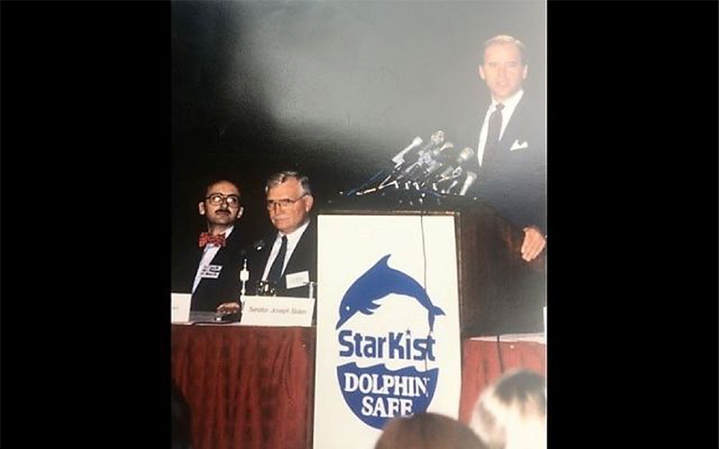
Then-Senator Joe Biden speaking at a press conference in support of dolphin-safe legislation in 1990,
with Ted Smyth pictured far left. COURTESY OF TED SMYTH
Joe Biden’s decency and love for ordinary people extends to combatting climate change and protecting the environment and animals.
*Editor's Note: This article was submitted to IrishCentral by Ted Smyth, President of the Advisory Board of Glucksman Ireland House NYU and Chair of the Clinton Institute for American Studies in University College Dublin. He is a former Irish diplomat.
For example, the Humane Society has endorsed Biden for his legislative record protecting wildlife and the environment, including laws that ban the use of dolphin-deadly nets when fishing for tuna.
I have personal knowledge of Biden’s sincere commitment to this issue from my time as Senior Vice President for Government Affairs at the Heinz Company. In the late 1980s, one of our affiliates, StarKist Tuna, was being pressed by environmental groups like Earth Island Institute to ban fishing for tuna by tracking dolphins under which tuna congregated in the Eastern Tropical Ocean.
It turned out that the purse seine nets would surround the tuna and the dolphins, resulting in the death of thousands of dolphins as by-catch. Earth Island Institute biologist Sam Labudde’s secret video of dolphins dying in tuna nets became viral on national television and school children especially were outraged, writing thousands of protest letters to the tuna companies. In response to this consumer action, Heinz in 1990 became the first company to stop buying tuna from boats that maimed dolphins, with Chicken of the Sea and Bumble Bee quickly following our lead. But we needed legislation to enforce the initiative, and I approached Senator Biden, then Chair of the Senate Judiciary Committee.
Senator Biden was immediately responsive, telling me that his nine-year-old daughter Ashley was part of the letter-writing campaign from grade schools to protect the dolphins. In a recent interview with Marie Claire, Ashley, who is now a social worker, confirmed this: “I became obsessed with the plight of dolphins getting stuck in tuna nets. "My dad connected me with Congressman Barbara Boxer, who I nicknamed the ‘dolphin lady,’ and she got me onto the floor to help lobby Republican members of Congress for a law to protect dolphins.”
Working closely with Senator Boxer, Biden persuaded Congress to pass the Dolphin Protection Consumer Information Act of 1990, formalizing “Dolphin Safe” labeling for tuna not caught with purse seine fishing methods. This act created a standard for tuna imported or exported in the United States. American consumers responded to the new labeling, and sales soared for tuna products labeled with the "Dolphin Safe" label.
While that successful legislation is a very small part of what Joe Biden has accomplished in a long public service career, to me it is just typical of the Vice President, responding positively to a problem, and coming up with a creative solution that could be supported by Republicans and Democrats, and cheered on by lovers of animals everywhere.
Sixty Irish American leaders
call for end to racism in honor of John Lewis
“This is no time for Irish America to be sitting on the sidelines
when it comes to racial justice.”
IrishCentral Staff @IrishCentral Jul 30, 2020
A demonstrator at a Black Lives Matter protest in Dublin. ROLLINGNEWSOver sixty leaders from Irish America’s broad civil, political and educational community have banded together to mourn the passing of John Lewis and announced a call to action to support the Black Lives Matter movement in its quest for racial justice.
The letter calls on all Irish Americans to support new racial justice initiatives from removing Confederate names at American military bases to supporting new efforts to expand voting rights and urges Irish Americans to boycott the sale of “Irish Lives Matters “T-shirts. The letter is explicit in supporting a non-violent peaceful protest to achieve racial justice. Former Congressman Joe Crowley, an organizer of the letter commented, “John Lewis believed in good trouble, smart trouble, the type of trouble that opens up people’s hearts and minds. We are in challenging times and there is great division in the country. We stand with John Lewis when it comes to smart, creative peaceful protest. We ask all Irish Americans to follow in his example.”
The letter is being sent to Congresswoman Karen Bass (D), the chair of the Congressional Black Caucus. Eleven members of Congress have signed on to the letter in a show of respect for their former colleague.
Former Congressman Joe Crowley and John Lewis getting arrested.Former Congressman Joe Crowley said “It was an honor to call John Lewis a mentor and friend. I was proud to walk many miles with him—crossing E. Pettus Bridge for his annual pilgrimage to Selma, protesting in the streets of D.C. for the rights of immigrants, sitting-in on the House Floor for gun safety—but I cannot claim to have walked in his shoes and no Irish American can. There continues to be dramatic racial inequality in America, and the Black Lives Matter movement is at the forefront of advocating for change. I support BLM; I support the fight for racial justice, and I oppose the sale of these tee shirts because they dilute and diminish the efforts of Black Lives Matter.”
Why Irish Americans must support Black Lives Matter Among those signing on to the letter are former Governor of Maryland Martin O’Malley, Cong. Richard Neal (D, Mass) Chair of the Friends of Ireland Caucus, Loretta Brennan Glucksman, former Chair of the American Ireland Fund, U.S. Ambassador to Ireland Kevin O’Malley and Ambassador Elizabeth Frawley Bagley, both of whom served under President Obama, noted author Colm Tobin, Niall O’Dowd, publisher of the Irish Voice and IrishCentral, Brian J. O’Dwyer, Grand Marshal 2019 Saint Patrick’s Day Parade, NYC, and former U.S Senator Gary Hart.
Congresman Richard Neal (D, Mass) Chair of the Friends of Ireland Caucus.The letter urges a boycott of “Irish Lives Matters” T-shirts now on sale on Amazon, Walmart and other retailers “protesting the wrongheaded, commercial decision” to sell “Irish Lives Matters” tee shirts. The letter states “we believe the sale of these T-shirts is at best tone-deaf and insensitive and at worst a deliberate, cynical attempt to trivialize, diminish or denigrate the BLM.”
The call to action also urges the “great institutions of Irish America, particularly our colleges and universities, as well as our civic and fraternal organizations to address their role in maintaining the institutional racism that has plagued this nation. The work being done by Georgetown University Slavery Project in acknowledging the university’s links to slavery is a clear example of what can be done.”
Ted Smyth, who helped to formulate the letter, stated, “We are very pleased that seven Irish Studies Programs at leading universities across the country have signed on to the letter. They can take a leadership role in continuing a growing and honest conversation between Irish America and Black America. They can also inspire a younger generation of Irish Americans to actively support racial justice and equality.”
Miriam Nyhan Grey, Director Graduate Studies and Associate Director Glucksman Ireland House, a signer of the letter stated, “The Black, Brown and Green Voices initiative represents a documentation strategy to give voice to the diversity of the Irish diaspora by recording life histories with Black and Brown Irish Americans. The interviews unpack how hierarchies of race and ethnicity have framed Irishness and the imperative to amplify the diversity of Ireland and her diaspora in the 21st century.”
Miriam Nyhan Grey, Director Graduate Studies and Associate Director Glucksman Ireland House.The letter developed out of lengthy conversations by a small group of Irish American leaders in the immediate aftermath of the death of Congressman Lewis. Brian O’Dwyer, the 2019 Grand Marshal of New York City Saint Patrick’s Day Parade, a participant in these conversations, commented “As a young man I worked to register Black voters in Mississippi, I am gratified that Irish American leadership has come together to reject racism and support the BLM movement”
Joe Crowley agreed, “We felt we had to do something tangible and specific in response to John’s death and the urgent demands for social justice. Over a century ago the great Irish Liberator Daniel O’Connell would tell the Irish to “agitate, agitate, agitate” for their voting rights. John Lewis urged Americans to make “good trouble” to secure their rights. John set the example of how peaceful, creative non-violent protest leads to great changes.We intend to follow John’s example. ”
Former Congressman Joe Crowley.Crowley continued, “You can make a lot of good trouble to get things done. This is no time for Irish America to be sitting on the sidelines when it comes to racial justice. America will be a better place if we are willing to support African Americans in their quest to overcome the long and intolerable legacy of racial discrimination. Now is the time.”
John Hume, the driving force behind the peace process in Northern Ireland, has died."Great peacemaker"
John Hume remembered
by longtime friend Ted Smyth
Former Irish diplomat Ted Smyth has paid tribute
to his longtime friend John Hume, who Smyth says "kept hope alive."
August 5, 2020
Editor's Note: The below was written by former Irish diplomat Ted Smyth, who now serves as the President of the Advisory Board at NYU's Glucksman Ireland House and the chair for the Clinton Institute for American Studies at University College Dublin.
The world has lost two champions of peace and equality in a matter of weeks, John Lewis and John Hume. Both of these giants of civil rights personified extraordinary political leadership, and in Hume’s case, secured a peaceful settlement in the brutal jungle of communal strife through meticulous navigation, granite-solid patience and the backstage support of both local and distant allies.
Hume’s achievements resonate all-too-memorably in an era marked by limp diplomacy and the impulsive resort to force throughout the globe. As John’s family said this week, “It seems particularly apt for these strange and fearful days to remember the phrase that gave hope to John and so many of us through dark times: we shall overcome."
John Hume "was radically committed to non-violence even during Ireland’s darkest hours," writes Ted Smyth
Former US president Bill Clinton, who became Hume’s friend, described him as “the Martin Luther King of the Irish conflict,” while the President of Ireland, Michael D Higgins, said he had “transformed and remodeled politics in Ireland” and praised his “personal bravery and leadership.”
In awarding Hume the Nobel Peace Prize (jointly with Unionist leader David Trimble), the Oslo jurists in 1998 cited his role as a principal architect of the Good Friday Agreement, which defanged the sectarian snakes in Ulster. On an island long riven by political and religious zealotry, Hume was radically committed to non-violence even during Ireland’s darkest hours. And an essential element in this long campaign was his skill in securing the support of three American Presidents, something no Irish leader had ever come close to before.
None of this seemed feasible in 1964, when Hume as a 27-year-old teacher in Derry, Northern Ireland, presciently outlined in The Irish Times the three principles which would underpin the 1998 peace settlement. He called for a rejection of violence, the recognition that uniting the British-ruled North with the Irish Republic was a legitimate goal only if achieved with Unionist consent, and that it was imperative to guarantee equal rights to all citizens of Northern Ireland.
I first met John in 1970 at the Trinity College Dublin’s Hist 200th anniversary when he expanded on his policies to achieve an agreed Ireland by peaceful means. In 1976, before I became Irish Government Press Secretary in the US, I stayed with John and Pat in their Bogside home and we remained steadfast friends ever since.
John Hume at wedding of Ted Smyth to Mary Breasted in New York City, 1980. (Courtesy Ted Smyth)In the ensuing and often terrible three decades, Hume kept hope alive and courageously faced down the British army and the Ulster police as they attacked and jailed demonstrators. In 1972, thirteen unarmed civil rights marchers were shot dead in Derry by British paratroops in what became infamously known as “Bloody Sunday.” Throughout this carnage, Hume hewed to the creed of non-violence, inspired by his heroes, Martin Luther King Jr. and Nelson Mandela. As a founder, and soon leader, of a new Social Democratic and Labor Party (SDLP), he spoke up for peace on being elected to both the British and European parliaments.
All the while, John nurtured ties with prominent Irish Americans, notably House Speaker Tip O’Neill, Senators Edward Kennedy and Daniel Patrick Moynihan, together with New York Governor Hugh Carey, soon dubbed “The Four Horsemen.” O’Neill valued his friendship with Hume and began urging successive administrations to hold the British government accountable for reforms in Northern Ireland. Kennedy, who met Hume in 1972, spoke for the quartet: “I believe it’s important to listen to the ones who are risking their lives and are attempting to do it in a non-violent way.”
Over time, this potent Irish American lobby helped persuade Jimmy Carter, Ronald Reagan, and Bill Clinton to resist the advice of their pro-British State Department and support inclusive peace proposals in Ireland. The history of this fruitful development is well told in the book and documentary by Maurice Fitzpatrick, "John Hume in America," confirming that absent White House support, the Irish peace process would have failed, as have many other peace initiatives in Asia, the Middle East, Africa, and Latin America.
For his part, President Carter faced down bruising British disapproval in becoming the first Chief Executive to insist in 1977 that Dublin had a legitimate role in any resolution of Belfast’s unending conflicts – and moreover, that Washington could support such a solution economically. Speaking years later, Carter recalled that it was a rare thing for the United States to take a position against the British, but that he did not consider it an internal affair as his predecessors had done: “I thought it was a challenge to human rights.”

1984: Ted Smyth in right background with the leaders of the New Ireland Forum in 1984,
including John Hume, Garret FitzGerald, Charlie Haughey and Dick Spring. (Courtesy Ted Smyth)In 1985, responding to Hume and the Irish government, Speaker O’Neill urged President Reagan to seek Prime Minister Margaret Thatcher’s approval of the breakthrough Anglo-Irish Agreement giving the Dublin government consultative rights in Belfast. A decade later, President Clinton wisely chose Senator George Mitchell to be the mediator who pressed for an IRA cease-fire, opening the way to the Good Friday Agreement.
In his Nobel Prize lecture, John Hume recalled that he had been strongly inspired by the European visionaries who “decided that difference is not a threat, difference is natural. Difference is the essence of humanity.”
His advice in Norway to his successors should be taken to heart: “I want to see Ireland as an example to men and women everywhere of what can be achieved by living for ideals, rather than fighting for them, and by viewing each and every person as worthy of respect and honor.” John Hume remains the only person to have received the Gandhi Peace Prize, the Martin Luther King Award, and the Nobel Peace Prize.
John Hume Nobel Peace Prize 1998: “Our differences are an …. https://youtu.be/vtU_zmajJHI
John Hume chose to play the long game for three decades. He shunned bombast, avoided the celebrity spotlight, and yet his achievements secure his stature as one of Ireland’s greatest leaders, alongside Daniel O’Connell and Charles Stewart Parnell. John’s best legacy now would be to protect the Good Friday Agreement and accelerate the process of reconciliation on the island of Ireland. His best monument would be to support the John and Pat Hume Foundation for Peaceful Change and Reconciliation.
@IrishCentral
Family friendly ways to celebrate
St. Patrick's Day in NYC
What are the best ways to spend St Patrick's Day in New York? From learning Irish to giving back, there are plenty of things that won't have you stuck in the pub all day on March 17.
By Ted Smyth and Malachy McCourt, Feb 25, 2020
Being Irish in New York on St Patrick's Day is really a special time - and it doesn't always have to involve a trip to the pub!
“There are two types of Americans on St Patrick’s Day: those who are Irish and those who lack ambition.” So goes the old joke which captures the love for Ireland across America, a continent with 40 million people of Irish descent.
There are wonderful parades and dances and festivals to celebrate the Irish national day all over New York and all over the
country, which is also a harbinger of spring.
As somewhat reformed veterans of March 17 excesses ourselves, we thought we'd suggest a few diversions to those seeking craic agus ceol (good times and music) in New York on the big day. Here are some suggestions for how to spend St. Patrick's Day in New York City that don't involve a pub:
Sober St. Patrick's Day
Join the "Sober St. Patrick's Day" hooley. Billed as the ultimate family-friendly party, the event features trad music, dancing,
actors and storytellers. For St. Patrick's Day 2020, the event will be hosted in New York, Connecticut, Virginia, Rhode Island, as well as Dublin.
The New York City St. Patrick's Day Parade
Celebrate all that is Irish by joining some 150,00 people at the NYC St. Patrick's Day Parade on March 17. What could be better than marching up Fifth Avenue in the allinclusive Irish celebration?
Get involved
Search online for news about other Irish activities and news on IrishCentral or Irish America magazine. The Irish Arts Center has many fun activities, including handing out books by Irish authors on March 17.
Play the part
Get in touch with your Irish roots by taking lessons in the uilleann pipes (there are now thousands of pipers worldwide up from fewer than a hundred 20 years ago), or if that's too complex, try the bodhran drum or the tin whistle.
Buy anything Irish: tweeds, Aran sweater, jewelry, crystal, Irish cheeses, anything except those t-shirts which say we Irish are
drunken bums.
Learn "cúpla focal"
Learn to curse and woo in Irish (as Gaelige) at Glucksman Ireland House at New York University. Be sure to check out their
website for a list of lively events and lectures.
Indulge in the Irish arts
Read a book of Irish poetry with your family and friends (the Penguin collection features three Nobel Laureates: Seamus Heaney, Samuel Beckett, and W.B. Yeats) or read
"How the Irish Saved Civilization" by Thomas Cahill. Or watch some great Irish movies recommended such as "Once," "The Crying Game," "The Snapper," and "My Left Foot."
Give back
The first observance of St Patrick’s Day was in 1737 by the Charitable Irish Society of Boston when they coordinated charitable works for the Irish community. Why not volunteer with City Harvest or any NYCbased charity during the day to honor this truly authentic way of celebrating the day?
Get moving
Head downtown to a walking tour of Irish sites such as the Irish Hunger (Famine) Memorial in Battery Park, or the Shrine of St Elizabeth Seton at the Holy Rosary mission in State Street. The Irish Famine Memorial in NYC
Get planning
Invite friends and family over for smoked salmon and Barry's tea to plan a trip to Ireland next year to explore your Irish roots.
Lá Fhéile Phádraig sona daoibh!
*Originally published in 2016, updated in 2020
How do you celebrate St. Patrick's Day in New York City? Share in the comments, or drop us a line!
RELATED: St. Patrick's Day, New York, Irish American
The future for Irish America is more Irish Studies programs across the US
Why Irish Americans and the Irish government need to join forces to ensure Irish American heritage and culture is not lost because of lack of emigration
by Ted Smyth April 26, 2019
Why Irish Americans and the Irish government need to join forces to ensure Irish American heritage and culture is not lost because of lack of emigration
There is a reason why US Speaker Nancy Pelosi and powerful Ways and Means Chairman Ritchie Neal were in Ireland last week, lending their considerable weight to the Irish government in preserving peace and preventing a hard border.
The reason is their personal and commendable support for peace and equality in Ireland coupled with the knowledge that millions of Irish Americans also care about preserving peace in Ireland. Addressing the Dail, the Speaker said that for generations, “Ireland has been the emerald thread in the fabric of American history and national life.”
Read more: This Irish university is offering an online course that explores all things Gaelic
However, that thread is fraying fast in the absence of new Irish immigrants to America, the aging of Irish American activists and the faster growth of other immigrant groups such as Hispanic and Asian. Unless we seriously engage the next generation of Irish Americans in their heritage the emerald thread will snap.
What can be done? A 2017 IrishCentral survey of Irish Americans under 45 concluded that staying connected to Ireland
via Irish studies appears to be the optimal way to engage the next generation.
Eighty-five percent were interested in studying Irish history, politics, and literature if courses were available locally in the
United States, 75 percent expressed a desire for online distance learning courses on Irish topics.
Significantly, 45 percent favored cultural programs in Ireland for young people, which could be met by a type of Irish Birthright program. For example, the Israeli government deploys 75 young Israelis to American universities to coordinate Friends of Israel groups and facilitate educational and Birthright trips to Israel.
The Irish Government is now reviewing all ideas for better engagement of our younger Americans of Irish heritage and readers are urged to email their proposals to the Irish Abroad Unit in the Department of Foreign Affairs at globalirishhub@dfa.ie
In the United States, the AmericanConference for Irish Studies (ACIS) is one of the leading organizations connecting younger Americans to contemporary Ireland. According to its new President Kate Costello-Sullivan, ACIS, a multidisciplinary scholarly organization founded in 1960, is becoming “an inclusive, dynamic, and diverse organization, in keeping with our highest principles and reflective of a multicultural Ireland.”
American Conference for Irish Studies (ACIS).
Dean of the College of Arts and Sciences at Le Moyne College in Syracuse, Costello-Sullivan (who is a fourth generation Irish American) pays tribute to her predecessor, Professor Timothy McMahon of Marquette University, for implementing ACIS’s first diversity statement, adding, “there was a time not too long ago when Irish studies was considered implicitly male.
She added also people assumed Ireland was implicitly white. ”I want to make sure that women and gender studies are interwoven in the fabric of the organization and our scholarship.”
The key for Professor McMahon is that the study of Ireland by young Americans is an important lens on so many issues facing the broader world today.
For example, the annual ACIS conference in Boston last month attracted academics from 12 countries, 41 U.S. states, 175 American colleges and universities, and 13 Irish colleges, generating 350 presentations over three days on a diverse range of topics including migration, transnational networks, race, women and violence, theater of protest, screen Ireland, peace studies, colonialism, post-colonialism, frontiers, liminalities and thresholds.
Keep up-to-date with IrishCentral's education news here
While a recent analysis by the American Association of Departments of English (ADE) noted that bachelor’s degrees
conferred to English majors are down 20% since 2012, it also noted, “responsive departments that know how to market their worth to students are finding new ways to thrive.” Irish Studies departments in America are a good example of such responsiveness.
Kelly Matthews, Vice President of ACIS and Associate Professor of English at Framingham State University in Massachusetts, notes, “Young people are just like us: they worry about their own future and the future of the world. Studying the past, the arts, the politics, and society of the present draws them in and connects them to conversations begun by scholars of
previous generations.”
Moreover, students who are studying science subjects frequently take an Irish studies course because it teaches them
valuable skills such as critical thinking, analysis, and research.
Kevin Kenny, Director of Glucksman Ireland House at NYU, observes that courses on immigration and diaspora are very popular among History and non-History majors: “The history of Irish immigrants holds important precedents for most of the issues at stake in the United States today, from the origins of migration to inequality and social mobility, and from religious toleration and nativist bigotry to political mobilization and government policy.
Glucksman Ireland House at NYU.
Without an understanding of how immigration worked in the past we have little hope of understanding how it works in
the present, let alone enacting reforms for the future."
Kelly Sullivan, Assistant Professor at New York University, reflects that “perhaps the most popular course I have taught at NYU is on Irish Women’s Writing, one of only a handful of courses in the university aimed specifically at reading work by women, and the strength and success of the course lies in making sure we have a robust historical context for the work we read.”
Many papers at the ACIS conference in Boston were devoted to the ever-popular Heaney, Yeats, Joyce, Lavin, Beckett, and Bowen, but contemporary Irish and Irish American writers and poets received more attention than in previous years, including highly acclaimed readings by Leontia Flynn, Emilie Pine, Michael Longley, Catherine McKenna, and Mike McCormack. University of Limerick Ethnomusicologist Aileen Dillane (most recently at the Keough- Naughton Institute) presented a fascinating paper on “Faith, Fury, and Feminism” in the songs of Sinead O’Connor. Dillane, building on the legacy of NYU professor Mick Moloney, researches how “Irish” music remains central to current representations of Irish and Irish American identity.
Notwithstanding the popularity of Irish Studies and its success in strengthening the bonds between Ireland and next generation Irish Americans, the limited funding to support chairs and professors in Irish courses restricts its ability to scale up in the way that Jewish studies have in America.
The Department of Foreign Affairs and the Northern Ireland Office have helped by providing some financial support, with the former funding a new website with features that ACIS believes will enable members to search and share Irish studies research across the globe. Such funding links town and gown in smaller cities, keeping Irish studies vibrant across the US. Irish universities also need to plan a united campaign in the United States to build an attractive brand for education in Ireland
that would complement a birthright program.
A select few Irish American philanthropists have generously contributed to endowing institutes and chairs of Irish studies in
America, including Lew and Loretta Glucksman at New York University, Brian Burns at Boston College, and Martin Naughton and Don Keough at Notre Dame. New York Times columnist Dan Barry states that such places are “the perfect example of the twinning of art and scholarship to remind us who we are and where the hell we might be going.”
But significantly increased funding from the Irish government and from private donors in Ireland and America is urgently required if the emerald thread is to be preserved by the next generation of young Irish Americans.
Ted Smyth is President of the Advisory Board of Glucksman Ireland House at New York University
Irish America has a vital role in North’s future
and in US-Europe Relations
The “Bridging the Atlantic” conference discussed new global trends and threats in transatlantic relations, including Brexit’s impact on the Good Friday Agreement.
December 13, 2019
By Ted Smyth
|
Pictured at Washington conference left to right, Suzanne Lynch, Irish Times, Irish Ambassador Dan Mulhall,
European Union Ambassador Stavros Lambrinidis, Congressman Brendan Boyle and Irish Europe Minister, Helen McEntee.
Photo Ted SmythThe “Bridging the Atlantic” conference, convened in Washington on December 5, 2019, discussed new global trends and threats in transatlantic relations, including Brexit’s impact on the Good Friday Agreement, the emergence of unprecedented digital battlefields, trade tensions, terrorism, migration, the rising power of China and the potentially reduced role of the United States in the world.
The conference, held at Riggs Library in Georgetown University, was sponsored by Professor Liam Kennedy of University College Dublin’s Clinton Institute, Professor Katrin Sieg, Georgetown University’s BMW Centre for German and European Studies, Professor Coilin Parsons, Georgetown University’s Global Irish Studies Initiative and by the Embassy of Ireland.
In her first major visit to Washington, the conference keynote address was delivered by Ireland’s Minister for European Affairs, Helen McEntee. The Minister noted that from the founding of the Irish state 100 years ago, “our state has been global in outlook, conscious that – culturally and politically, as much as geographically – we lie at the point where east and west converge. At the center of transatlantic relations, part of Europe, but inextricably bound to America.”
McEntee observed that the United States had always been a source of strength to Ireland, “from Tip O’Neill to Richie Neal, Ted Kennedy to Pete King, and Daniel Patrick Moynihan to David Patrick Joyce, the Caucus’s members, Democrat and Republican, helped lay the foundations for the Good Friday Agreement. A compromise which, of course, was brokered by a Senator from New England and which was guaranteed by international law, laid at the United Nations in New York."
The Irish Minister said the priority now was “first to safeguard, and then to strengthen, the essential partnership between the European Union, in which Ireland has built her home, and the United States, our most important ally and dearest friend across the Atlantic.”
The speakers who followed expressed a warm welcome for the December 3 US House of Representatives vote which declared unanimously that the House would reject any US-Europe trade agreement that threatened the Good Friday Agreement.
Rep Brendan Boyle (Pa), the chair of the Congressional Friends of Ireland and a sponsor of the resolution, told the conference that the US Congress was totally committed to peace in Ireland.
Former Member of Congress Bruce Morrison noted that “It’s a gift that important members of Congress care about the people of Northern Ireland. Ireland is the number one issue for Congress when it’s a number one issue, like when peace is threatened by a resumption of a hard border.”
The Irish Ambassador Dan Mulhall stressed that Irish America remains a vital force in US-Ireland relations and that contrary to some assertions, it is not a wasting asset. “Irish Americans around the country have displayed an immense interest in preventing Brexit from destroying peace in Ireland,” he noted.
In addition to relations based on kith and kin, the contemporary relationship with Irish Americans is underpinned by a two-way US-Ireland trade in goods and services, and by the visit of two million Americans to Ireland every year, including 12,000 American students. Along with Israel, the Ambassador added, Ireland has the most devoted diaspora in the US.
Amongst the panelists were Dr. Katy Hayward, an authority on Brexit from Queen’s University Belfast; Dr. Kevin Hassett, and Gail Slater, former officials in the Trump White House; Brett Bruen a former Obama White House official; Dr. Orlaigh Quinn, Secretary-General of Ireland’s Department of Business; Dr. Tom Wright of Brooking; Andrew Elliot, Director of the Northern Ireland Bureau in DC; and Dr. Karen Donfried, President of the German Marshall Fund.
The first panel noted that Northern Ireland, at the center of dramatic Brexit events, is in “a state of time-between-times,” a point at which one paradigm is collapsing and a new one has yet to emerge.
The recent General Election results confirm this change where for the first time in the history of Northern Ireland unionist MPs are in a minority. More voters also voted for the center ground and stressed they want a return to local government at Stormont.
It was suggested by one panelist that the United States could help Northern Ireland in three ways:
1. Provide stability to maintain the Good Friday Agreement. The US shares ownership of the Northern Ireland peace process, regarding it as one of its signature successful peace processes in the past 50 years.
2. Help build confidence in both communities and minimize uncertainty. There is a need for more investment in education, innovation, agri-food, high tech, and 21st-century skills.
3. Strengthen the middle ground in Northern Ireland and avoid polarizing initiatives. For example, talk of a border poll needs to be treated with care. Another speaker emphasized the need for balance; if there is something in it for nationalists, there must be something in it for unionists. Once things go wrong for one side, they go wrong for the other side.The second panel discussed Transatlantic Trade and Investment and Ireland’s important role in US-EU relations post-Brexit. One speaker noted that transatlantic trade is now 40% of global GDP and that 700 Irish companies invest in the US employing 100,000 people. Ireland is the ninth-largest foreign investor into the USA.
Another panelist maintained that American government allegations that the EU enjoyed an unfair trade advantage over the US were inaccurate and damaging to US-Europe solidarity. It was noted that 48 out of 50 US states export most of their goods to the EU.
In terms of digital trade, one American business representative said Ireland is at the center of connectivity between the US and EU, holding one-third of EU data, with nine out of ten top digital companies maintaining European headquarters in Ireland.
In effect, Ireland is now the API (Application Program Interface) between competing digital systems in the world, raising questions of data privacy and protection.
Ireland has come from 45th in the global ranking for scientific innovation in 2000 to 12th today. It was noted that one of Ireland’s strengths is its capacity for collaboration, innovating in partnership with government, business, and academia.
There is an important role for Ireland to play in ensuring security and surveillance safeguards around the deployment of globally competing 5G networks.
The third panel focused on the Future of Transatlantic Relations post-Brexit.
Panelists agreed that while the EU is one of the greatest peace processes in the world (a point made by John Hume in accepting the Nobel Peace Prize 21 years ago), Brexit presents one of the most significant challenges to Europe and the US since the end of the Cold War.
While NATO was founded post World War II to counter the security threat from the Soviet Union, NATO must now, with the EU (22 countries are members of both NATO and the EU), counter threats from China, cyber warfare, terrorism, and migration.
Regardless of who is in the White House, it was stressed that good US-EU relations are essential. One speaker noted that China is seeking domination through its Belt and Road Initiative and in buying roads, land, and ports.
Some speakers felt that US Europe relations must be fundamentally reconstructed, educating the public on both sides of the Atlantic regarding common values and why our mutual interest in democratic government must be protected from hostile dictatorships.
In view of the success and relevance of the conference, the organizers are considering the feasibility of organizing a similar conference annually.
Ted Smyth is Chair of the Advisory Board of University College Dublin’s Clinton Institute and President of the Advisory Board of Glucksman Ireland House at NYU.
